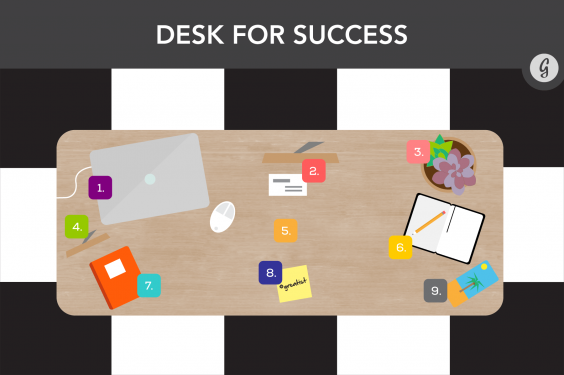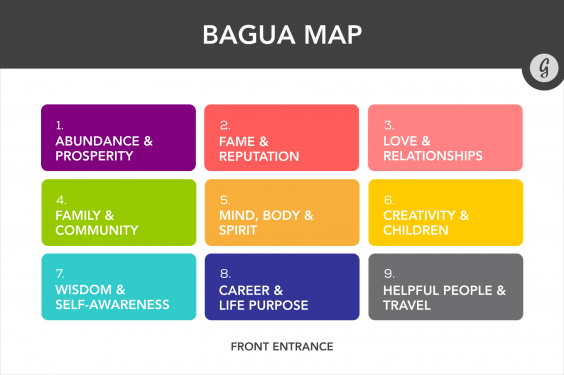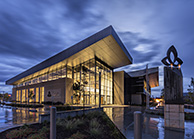Feng shui (pronounced "fung shway") is the ancient Chinese practice of arranging physical objects to attract positive energy. It’s based on the idea that everything in a person’s surrounding environment affects his or her inner life.Feng shui practitioners believe that the placement of objects in a room, building, or other space will affect the flow of chi (life force or essential energy) within the space. If there’s good chi flowing, whoever’s in the space will get a boost of positive energy. Pretty sweet, right?
According to feng shui expert RD Chin, people often turn to the practice if “they don’t feel right or comfortable in their space.” Perhaps nowhere is this more relevant than in the workspace—painful chairs, bad lighting, and a boss breathing down our necks hardly promote feelings of comfort. That’s where feng shui comes in. If you’re looking to feel a little more “at home” even while at work, or just want to send some good vibes your way on the job (promotion, anyone?), read on to find out how to use feng shui on your desk!
While there are few to no scientific findings that look at the effectiveness of feng shui directly (just, you know, thousands of years of Chinese tradition), some research backs up the practice’s basic principles. One study suggests that getting more organized can improve time management, which helps boost productivity at work . And psychology research found that adding natural elements—such as sunlight, green plants, and physical movement—to the workplace can boost employee health, happiness, and productivity . How’s that for some positive energy?
So how is feng shui different from just getting organized or decorating better? “It goes beyond just decorating because feng shui has a psychological component to the principles, says Laura Cerrano of Feng Shui Manhattan. "Your surroundings have a deep and profound impact on your emotional, mental, physical, and spiritual well-being.” Since the daily nine-to-five makes up a big part of the day, improving the chi in the workspace will help you out at work and in the rest of your life.
Getting Started: How to Feng Shui Your Desk
One of the basic tools for a feng shui practitioner is the bagua map.It’s a nine-part grid depicting the different areas of a space (home, desk, office, what have you) and how they correspond to different areas of life. Think of it as a general blueprint for any feng shui endeavor. To let the positive energy flow, follow the basic guidelines below.
Orient Your Desk
If possible, place your desk directly opposite the front door of your office. If you don’t have a private office, try to orient your desk to face the main door. Cerrano calls this a “commanding position.” If your boss isn’t willing to accept furniture rearrangement in the name of chi, Cerrano says that arranging a small mirror on your desk to reflect the office’s entrance is the next best thing. “According to the principles of feng shui, this arrangement offers protection and symbolizes you seeing opportunities as they come to you during your career,” Cerrano says. In other words, you have to be able to see opportunities in order to seize them.
Make Room for Creativity
Once you have a full view of any incoming opportunities, it’s time to tackle the desk's surface. Chances are there’s a bit of clutter, which Cerrano defines as “anything unfinished, unresolved, tolerated, or disorganized.” Clear the clutter and organize things in a way that suits your work style and personal preferences. Cerrano suggests organizing by date or category, using colored binders if that appeals to you. Getting organized can boost productivity, while clearing clutter can provide a space that allows creativity to flow .
Desk for Success
Now comes the fun part: arranging your desk to promote the flow of positive energy.

Imagine the desktop divided into a nine-part grid, as in the bagua map shown above. Choose several areas of your life that could use a little boost, and use the following tips to attract good energy to those areas. Each section is associated with a color, and you can use objects of that color if you have them. Just don’t go overboard—remember, clutter blocks creativity, so at least 50 percent of the desktop should be clear at all times. Don’t focus on all nine sections; instead, select two to three priorities.
- Wealth and Prosperity The back left corner of the desk represents prosperity. Target this space to attract money and abundance. It’s a great place for a plant, but if your green thumb is more on the brown side, consider placing a valuable item (such as a crystal vase or jar of change) in this corner. This could also be a good spot for a (well-functioning) computer.
- Fame and Reputation Want more than 15 minutes in the spotlight? In the center back of the bagua map, you’ll find the space for fame. Place business cards or a nameplate here. Cerrano also recommends “motivational images that highlight who you are and your accomplishments” (think: a photo of your first marathon finish or your hard-earned diploma).
- Love and Relationships To find a little love today (or in the future), focus on the back right corner. Single? A fresh flower, which can bring luck and maybe even spark romance, goes here. Already have a special someone? Place a photo of the two of you here.
- Family Although it’s a cliché desktop feature, a family photo, according to feng shui principles, fits well on the left center of the desk. A wood frame enhances the energy of this particular space.
- Health Although sitting at a desk doesn’t do much for your health, there are a few ways to promote health even while working. Keep the center area of the desktop free of clutter to attract good energy to the area. In addition, Cerrano recommends taking short breaks throughout the day to reduce stress and maintain focus.
- Creativity Boost creativity by adding inspiration to the right center of the grid. Aspiring writers, place a journal or book here. A blank sketchbook would be ideal for artists, while a metal object may work well for others. But really, anything goes—just get creative!
- Knowledge and Wisdom Struggling to learn new material, or just want to be wise beyond your years? Focus on the front left corner of the desk. Place a reference book (or maybe a picture of Albert Einstein) here.
- Career Front and center is the career space—definitely appropriate for a desk. Keep this spot free of clutter. Cerrano suggests displaying affirmations or motivational quotes around the office; this would be a great place to stick one of those.
- Helpful People and Travel If you’re in need of a little help from your friends, focus on the front right section. This is a good spot to put a phone or an address book (do people use those anymore?). This area also represents travel, so a travel guide or a photo of a dream vacation locale would work well here.
The Takeaway
Feng shui isn’t a magic formula; rather, it provides a visual reminder of the areas of life that you value or are working to improve. Chin notes that feng shui is a “matter of perspective, a way of thinking or creating balance in our lives.” Start by following the guidelines above as a way to add positivity and balance to your desk—and to your life!




